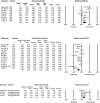Efficacy of Traditional Chinese Exercise in Improving Gait and Balance in Cases of Parkinson's Disease: A Systematic Review and Meta-analysis
- PMID: 35847669
- PMCID: PMC9285003
- DOI: 10.3389/fnagi.2022.927315
Efficacy of Traditional Chinese Exercise in Improving Gait and Balance in Cases of Parkinson's Disease: A Systematic Review and Meta-analysis
Abstract
Background: The efficacy of traditional Chinese exercise (TCE)-based intervention in the improvement of motor function in patients with Parkinson's disease (PD) is controversial. The present study aimed to assess the effects of TCE on balance and gait outcomes, as well as motor symptoms in individuals with PD, and evaluate potential discrete moderators such as TCE dosage-related variables.
Method: PubMed, Embase, Cochrane's Library, Web of Science, Medline, and Scopus were systematically searched from their dates of inception to February 2022. All studies were randomized controlled trials (RCTs) of TCE-based interventions for PD. The treatment effects were estimated using a random-effect meta-analysis model with standardized mean differences (Hedges' g). The Physiotherapy Evidence Database was used to evaluate the methodological quality of the study.
Result: Fifteen studies involving a total of 873 participants were included in the final analysis. The meta-analytic findings revealed significant improvements in balance outcomes [Berg Balance Scales (BBS) (g = 0.83, 95% CI = 0.37-1.29, p = 0.000, I2 = 84%), time up and go (TUG) (g = -0.80, 95% CI = -1.13- -0.47, p = 0.000, I2 = 81%), and the one legged blind balance test (g = 0.49, 95% CI = 0.13-0.86, p = 0.01, I2 = 10%)], as well as gait outcomes [gait velocity (g = 0.28, 95% CI = 0.02-0.54, p = 0.04, I2 = 64%), 6-min walking test (6MWT) (g = 0.32, 95% CI 0.01-0.62, p = 0.04, I 2= 15%), stride length (g = 0.25, 95% CI = 0.08-0.41, p = 0.003, I2 = 42%)], and motor symptoms [Unified Parkinson's Disease Rating Scale part III (UPDRS-III) (g = -0.77, 95% CI = -1.06- -0.48, p = 0.000, I2 = 76%)]. However, cadence (g = -0.03) and step length (g = 0.02) did not differ significantly. The moderator shows that the effects of TCE on BBS and gait velocity were moderated by Pedro score, exercise type, control group type, and number of sessions. Meta-regression found that TCE (exercise duration, number of sessions, and session duration) was significantly associated with improved UPDRS-III and BBS scores.
Conclusion: These findings provide evidence for the therapeutic benefits of TCE as an adjunct therapy for patients with PD. TEC dosage (high-intensity long sessions) may moderate some favorable effects.
Systematic review registration: PROSPERO, identifier CRD42022314686.
Keywords: Parkinson's disease; balance; gait; meta-analysis; traditional Chinese exercise.
Copyright © 2022 Wu, Tang, Wang, Zhang, Song, Teng and Zhu.
Conflict of interest statement
The authors declare that the research was conducted in the absence of any commercial or financial relationships that could be construed as a potential conflict of interest.
Figures





Similar articles
-
Effects of transcranial direct current stimulation alone and in combination with rehabilitation therapies on gait and balance among individuals with Parkinson's disease: a systematic review and meta-analysis.J Neuroeng Rehabil. 2024 Feb 19;21(1):27. doi: 10.1186/s12984-024-01311-2. J Neuroeng Rehabil. 2024. PMID: 38373966 Free PMC article.
-
Parkinson's disease motor intervention patterns: a network meta-analysis based on patient motor function.Front Neurol. 2024 Sep 5;15:1432256. doi: 10.3389/fneur.2024.1432256. eCollection 2024. Front Neurol. 2024. PMID: 39314864 Free PMC article.
-
Effects of Baduanjin exercise on motor function, balance and gait in Parkinson's disease: a systematic review and meta-analysis.BMJ Open. 2022 Nov 15;12(11):e067280. doi: 10.1136/bmjopen-2022-067280. BMJ Open. 2022. PMID: 36379643 Free PMC article.
-
A systematic review and meta-analysis on effects of aerobic exercise in people with Parkinson's disease.NPJ Parkinsons Dis. 2022 Oct 31;8(1):146. doi: 10.1038/s41531-022-00418-4. NPJ Parkinsons Dis. 2022. PMID: 36316416 Free PMC article. Review.
-
Effects of traditional Chinese exercise on physiological indicators and quality of life in patients with coronary heart disease: A systematic review and meta-analysis.Medicine (Baltimore). 2023 Jun 30;102(26):e34233. doi: 10.1097/MD.0000000000034233. Medicine (Baltimore). 2023. PMID: 37390231 Free PMC article.
Cited by
-
Comparing the effectiveness of type of the traditional Chinese exercises, frequency, intensity, time in osteoporosis: a protocol for systematic evaluation and network meta-analysis of randomised controlled trials.BMJ Open. 2022 Nov 24;12(11):e063878. doi: 10.1136/bmjopen-2022-063878. BMJ Open. 2022. PMID: 36424112 Free PMC article.
-
Effects of tai chi on postural balance and quality of life among the elderly with gait disorders: A systematic review.PLoS One. 2023 Sep 28;18(9):e0287035. doi: 10.1371/journal.pone.0287035. eCollection 2023. PLoS One. 2023. PMID: 37768953 Free PMC article.
-
Effects of Square Stepping Exercise on Physical, Cognitive and Psychosocial Fitness in People with Parkinson's Disease.Psychiatr Q. 2025 Aug 13. doi: 10.1007/s11126-025-10197-9. Online ahead of print. Psychiatr Q. 2025. PMID: 40802167
-
The impact of aerobic exercise dose based on ACSM recommendations on patients with Parkinson's disease: a systematic review and meta-analysis of randomized controlled trials.Front Aging Neurosci. 2024 Oct 3;16:1419643. doi: 10.3389/fnagi.2024.1419643. eCollection 2024. Front Aging Neurosci. 2024. PMID: 39430975 Free PMC article.
References
-
- Amano S., Nocera J. R., Vallabhajosula S., Juncos J. L., Gregor R. J., Waddell D. E., et al. . (2013). The effect of Tai Chi exercise on gait initiation and gait performance in persons with Parkinson's disease. Parkinsonism Relat. Disord. 19, 955–960. 10.1016/j.parkreldis.2013.06.007 - DOI - PMC - PubMed
-
- Carcelén-Fraile M. D. C., Aibar-Almazán A., Martínez-Amat A., Brandão-Loureiro V., Jiménez-García J. D., Castellote-Caballero Y., et al. . (2021). Qigong for muscle strength and static postural control in middle-aged and older postmenopausal women: a randomized controlled trial. Front. Med. 8, 784320. 10.3389/fmed.2021.784320 - DOI - PMC - PubMed
Publication types
LinkOut - more resources
Full Text Sources

